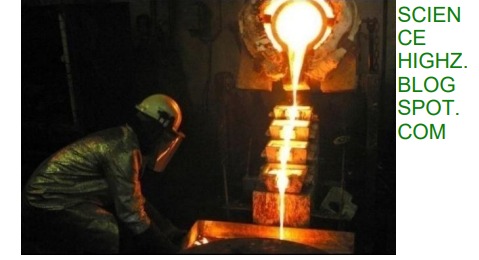INTRODUCTION
Most metals appear naturally as compounds in their ores. These ores are not useful for anything, therefore, in order to work with them, the pure metal have to be extracted from their ores. Ores are naturally occurring rock containing high concentrations of one or more metals that can be profitably mined.
Ore minerals are the minerals within ores that contain the metal. Ores occur as large bodies of rock called ore deposits, which are metal-bearing mineral deposits.
EXTRACTION OF ALUMINIUM
Aluminium is extracted from bauxite. Bauxite contains the hydrated oxide of aluminium (Al2O3.3H2O), silica (SiO2) and iron (II) oxide impurities.
Stages in the extraction of aluminium
There are two stages involved in the extraction of aluminium
1. Purification of bauxite to get alumina
2. Electrolysis of alumina
Purification of bauxite
Dry and crush bauxite to powder.
Dissolve or digest the powdered bauxite in hot concentrated sodium hydroxide (NaOH).
The hydrated oxide of aluminium, reacts with sodium hydroxide to give sodium aluminate, while silica reacts with NaOH to form sodium trioxosilicate (IV). The reaction equations are:
Al2O3 + 3H2O + 2NaOH → 2NaAl(OH)4
SiO2 + 2NaOH → Na2SiO + N2O
Iron (II) oxide, on the other hand does not react with sodium hydroxide, therefore it is filtered off.
The solution is seeded with crystals of pure aluminium oxide, Al(OH)3 to precipitate out solid aluminium hydroxide.
The solid aluminium hydroxide is washed, filtered and heated.
This causes the hydroxide to lose water leaving pure aluminium oxide, Al2O3, called alumina.
2Al(OH)3 → Al2O3 + 3H2O
(Flow chart of diamond extraction)
Electrolysis of alumina
Because aluminium is very reactive, it cannot be extracted from alumina by heating with carbon. It is, therefore, extracted by electrolysis. That is passing an electric current through alumina using graphite electrode in a process known as Hall process, using Hall cell.
The electrolysis process
The alumina is dissolved in liquid cryolite (sodium aluminum fluoride), Na3AlF6.
Aluminium oxide is decomposed into aluminium ions, Al3+ and oxide ions, O 2 .
Aluminium ions are extracted to the negative electrode (cathode) where they gain electrons to become aluminium atoms. Al3+ + 3e−→ Al
Oxide ions are extracted to the positive electrode (anode) where they lose electrons to become oxygen molecules; 2O2− – 4e−→ O2
(Hall cell)
EXTRACTION OF GOLD
Unlike aluminium, gold is un-reactive: thus, does not form compounds with other elements in its ore. This means that the gold ore is in its native or un-combined form.
The extraction process
The gold ore is ground into fine powder.
Water is added to form slurry (a watery mixture of insoluble ore particles).
The slurry is dissolved or leached in a solution of sodium cyanide and oxygen to form a soluble gold cyanide called dicyanoaurate(I), Au(CN)2. 4Au + 8NaCN + O2 + 2H2O → 4NaAu(CN)2 + 4NaOH
The gold ion is absorbed or attached to the surface of carbon and then desorbed or detached by washing with sodium cyanide solution. Absorption and desorption remove impurities and increase the concentration of the gold
The gold is electrolysed in a process known as electrowinning. Electrowinning is the process of using electricity to recover pure gold from its ore.
The reaction that takes place during the electrolysis is: [Au(CN)2] − + e−→ Au + 2CN−
The gold is deposited at the steal cathode.
The crude gold is heated without melting in order to eliminate moisture and other impurities in a process known as calcinations.
The calcined gold is finally smelted in which the gold is mixed with chemicals called flux and then melted into a yellow liquid and then allowed to solidify into gold bars.
(Gold extraction process)







No comments:
Post a Comment